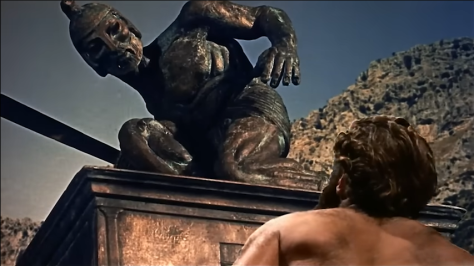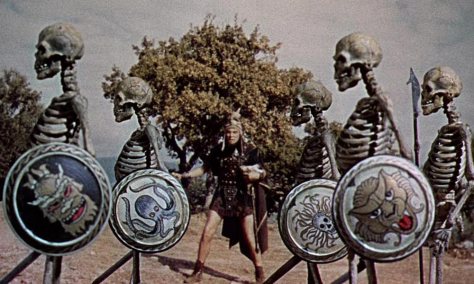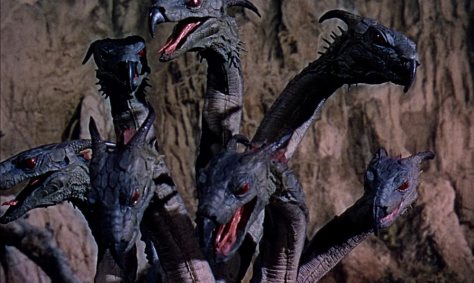
Ray Harryhausen’s stop motion animation sought to continue and improve upon the naturalism seen in the work of his mentor Willis O’Brien, transforming fantastical ideas into living, breathing things, and demonstrating the new dimension film can bring to the collective imagination. There did come a point, though, where it no longer seemed like a creatively fulfilling challenge to animate colossal, city-wrecking creatures in movies that were, in truth, slight variations of each other (he had worked on at least four of them by 1957, if you include Mighty Joe Young)—and to really move into a new phase, Harryhausen and his producer partner Charles H. Schneer pivoted to fantasy films starting with The Seventh Voyage of Sinbad in 1958, leaving behind the concerns of the age for a realm of pure story. No longer would Harryhausen be stuck contrasting his giant beasts with the concrete canyons of the modern world, but working in a wider variety of classical settings—and more than that, he was given the opportunity to apply his animation talent not just to the lumbering mutant animals and extraterrestrials that populated the fifties creature feature boom, but to the magical, implausible monsters found across legends and mythologies. Here, finally, was a new and rewarding challenge: bringing naturalism to the unnatural.
It was likely inevitable that Harryhausen would work on a story from Greek mythology, a setting in dire need of some technical craft after years of cheap Italian sword-and-sandal films. For fans of monsters of all shapes and sizes, those tales are among the inescapable urtexts, a boundless fount of unearthly creatures diverse in appearance and abilities, inexorably attached to the stories of great heroes that have influenced adventure stories across history. If any monsters could be said to be eternally iconic, the ones from these myth are at the top of the list, and to bring them to life on film would be a defining achievement for any monster maker. Jason and the Argonauts, the first (but not last) of Harryhausen’s Greek myth movies, ranks highly in his filmography both for its sense of wonder and its authenticity, conjuring the world as described in those stories on screen and populating it with larger-than-life figures.


Among the things I get from Jason and the Argonauts, it’s a sense that the people behind the camera, including screenwriters Beverley Cross (a frequent contributor to Harryhausen effects films) and Jan Read, understand the structure of most Greek myths: episodic, full of arbitrary stops and starts, and depicting characters at the whims of cosmic forces working through their own machinations. The story of Jason’s quest to retrieve the Golden Fleece from Colchis and regain the kingdom of his birth parents is full of familiar tropes—the hidden child of royalty who returns to usurp the usurper, a ruler bedevilled by a prophecy, and an attempt to rid himself of the problem by giving the hero an impossible task—that make something of a primer for the form. It also has a sort of “greatest hits” quality, as Jason’s titular crew on the ship Argos consists of numerous other notable figures from the myths, to whom this journey is just one story among many for them. It’s the kind of story where you have a character as bombastic as Heracles/Hercules there as a supporting player, and he leaves halfway through (or in the case of the movie, even earlier)—it’s quite a bargain for myth maniacs.


As one might expect, the film deviates from the source material in several places, streamlining it, fitting it to the “modern” sensibilities of 1963 (which is to say that the romantic love between various male characters is made less explicit, but I’d say it’s still there in spirit), and in some cases emphasizing certain angles of the myth, as retellings have often done over the centuries. Yes, Jason (Todd Armstrong, overdubbed by an uncredited Tim Turner) is still dedicated to returning to the throne of Thessaly and kicking out the corrupt king Pelias (Douglas Wilmer), but his decision to take on the quest for the Golden Fleece is not just a means to that end—as Jason explains, simply replacing the bad ruler would not be sufficient to heal the kingdom. What the people really need is to witness a miracle so that they know for certain that they have not been abandoned by the gods of Olympus. The gods themselves know this as well, and in their blue sky abode above the world, they watch events through a television-like pool or as an elaborate tabletop game, and their motivations and moods are suitably tangled. Jason is favoured by queen of the gods Hera (future Pussy Galore Honor Blackman), who takes particular umbrage when her husband Zeus (Niall MacGinnis) “inspired” Pelias to overthrow the previous king, which led to bloodshed in her temple in Thessaly. Zeus claims that the murder was not part of whatever deal he had with Pelias, and that the whole thing was simply one part of an elaborate set-up where Pelias inevitably falls to a “man with one sandal” (i.e. Jason), and rather than oppose his wife, he simply sits back and commentates as she guides her chosen hero towards his goal.


There is, in fact, a surprising amount of discussion of free will and the faith people have in the gods, a complicated relationship with their patron deities and the teleology that they control. The gods are fully capable of intervening in events when they feel like it—Hera gets the ship builder Argos (Laurence Naismith, seen later in Valley of Gwangi) to build a figurehead of her on the stern of the ship so she can speak with Jason semi-frequently—but are theoretically limited by the impositions they place on each other as part of their world-game, eventually leaving the mortals to face most of the journey alone. Many of the episodes deal with the crew navigating the work of the gods, often with the monsters acting as enforcers, including the section where Hercules (a particularly ebullient Nigel Green) steals their treasure against Jason’s word (based on Hera’s advice) and brings the giant brass guardian Talos to life, or when they witness the punishment meted out to the blind seer Phineus (Doctor Who and The Gorgon‘s Patrick Troughton.) In the latter case, they help him out of that punishment by imprisoning the Zeus-deployed harpies, working against the will of the gods when they see it as pointless and petty (as Phineus laments “Zeus, I was a sinner…but I didn’t sin every day. Why then do you punish me every day?”) All of the conflicts and monsters they deal with are part of a game where the gods are willing to pit their own followers against each other (the Golden Fleece was a gift from Zeus to Colchis that brings them peace and prosperity, and they are not unjustified in viewing Jason’s attempt to claim it as pure theft), where characters like Medea (Nancy Kovack, uncredited dub by Eva Haddon) are forced to choose between serving their own gods and following their hearts, and where their mercurial whims can stymie the course in one second and save it another. Jason benefits from the mercy of the gods on several occasions, but you can understand why it still might feel like a frustrating runaround, to the point where he says outright that “The gods of Greece are cruel” and “one day, all men shall learn to live without them.” Zeus himself admits that their power comes from the sustained faith of mortals, which only further complicates their capriciousness. It’s almost like an intriguing argument for defiant agnosticism in a world where the divine is very real and active, giving it another point of appeal alongside the Greek myth movie tradition of seeing British character actors in togas kibbitz among the clouds.


All of that, of course, is background for the main attraction, which are the series of effect sequences showcasing some of the legendary episodes of those myths. Four of the great creature sequences in Harryhausen’s career can be seen here, each one offering a different animation challenge. The harpies are human-sized and feature twitchy, animalistic behaviours and some pretty direct interactions with the human cast; Talos is an early and astounding display of scale, whose expressionless automaton movements are appropriately stiff but frighteningly swift; the hydra that guards the Golden Fleece is an extremely complex creature with so many moving parts that trying to animate it seems like a path to madness (the dragon that guarded the Fleece in the myth had one head, so Harryhausen intentionally chose to make it more difficult for himself); and the climactic battle with the skeleton soldiers born from the hydra’s teeth offer one of the more impressive and influential moments where live action and animation was truly combined (and is an intentional escalation of the skeleton sword fight in Seventh Voyage of Sinbad.) Each one is their own distinct beast, with unique, considered behaviours that give them so much character—the way Talos slowly springs to life, turning its head and staring with its eyeless sockets, is an effective introduction, and the moment when it suddenly appears from behind a rock outcropping as the Argos is about to escape is classic giant monster stuff. All of this is afforded a proper sense of scope, as director Don Chaffey (later of One Million Years BC) composes shots that give a sense of the natural landscapes, the islands covered in ruins, the arcane and mysterious temples to Hecate on Colchis, and the vast ocean that emphasizes the scale of their journey. These monsters exist in a properly fantastical world of open seas and endless islands, an example of Harryhausen really being simpatico with the live action director he works with. That also goes for the score provided by Bernard Herrmann (who among the numerous famous movies he worked on, scored It’s Alive and It Lives Again), whose booming, heroic sweeps makes every sequence feel all the more grand.

To multiple generations of usually younger viewers who had discovered and loved Greek myths—like me!—the monsters described in them feel like the sort of things that could only exist in dreams. You would read descriptions of Talos or the hydra in a book, and they would seem equally wonderful and impossible (at least various interpretations of the hydra would appear in other media, while poor Talos rarely got the same love), so seeing them move and act in this “real life” film just as you imagined them could be a revelation. More than just mere representations, though, these are creatures really do appear to have minds of their own, reacting to the humans around them and otherwise demonstrating a level of personality that makes them more than mere puppets. The pack of marauding skeletons show as much energetic malice as any swashbuckling foes portrayed by actors, with fight choreography that allows them to be deadly or comedic (such as when one gets its head kicked off and topples after it); Talos’ “death scene” feels not like a big metal toy falling over but like a massive structure falling over, dramatic and impactful. The level of consideration in these individual sequences is what separates Harryhausen’s effects from his contemporaries, and from many of his successors, and it’s especially impressive given that, unlike the dinosaurs and large animals that also defined his career, he had to think through the animations entirely through his imagination. There are, in fact, no scientific sources that can give one an inkling of how a hydra should act.

One of the benefits of working with myths is that it gives you that kind of room for interpretation—feel free to change things around, because even the source material is inconsistent!—and it’s something that both the live action and animated sections take advantage of. There’s a rock solid story structure to work with (even if that structure also allows them to, say, end the movie without necessarily tying up all the loose plot threads, because Zeus is there to tell us that Jason still has plenty of other things to—and according to the stories, he does!), episodes that come with exciting visuals and themes already built in, giving the screenwriters a chance to posit their own take on a world of gods and mortals, and a chance for Harryhausen to make each of its iconic monsters his own. Seeing these creatures given substance and reality is a dream come true for many (and it’s the kind of substance and reality where you can still go and look at them in person right now, if Harryhausen’s family has lent his model collection to your local museum for an exhibit), and draws the direct through-line between the monster movie and the ancient stories that were always their antecedents.
